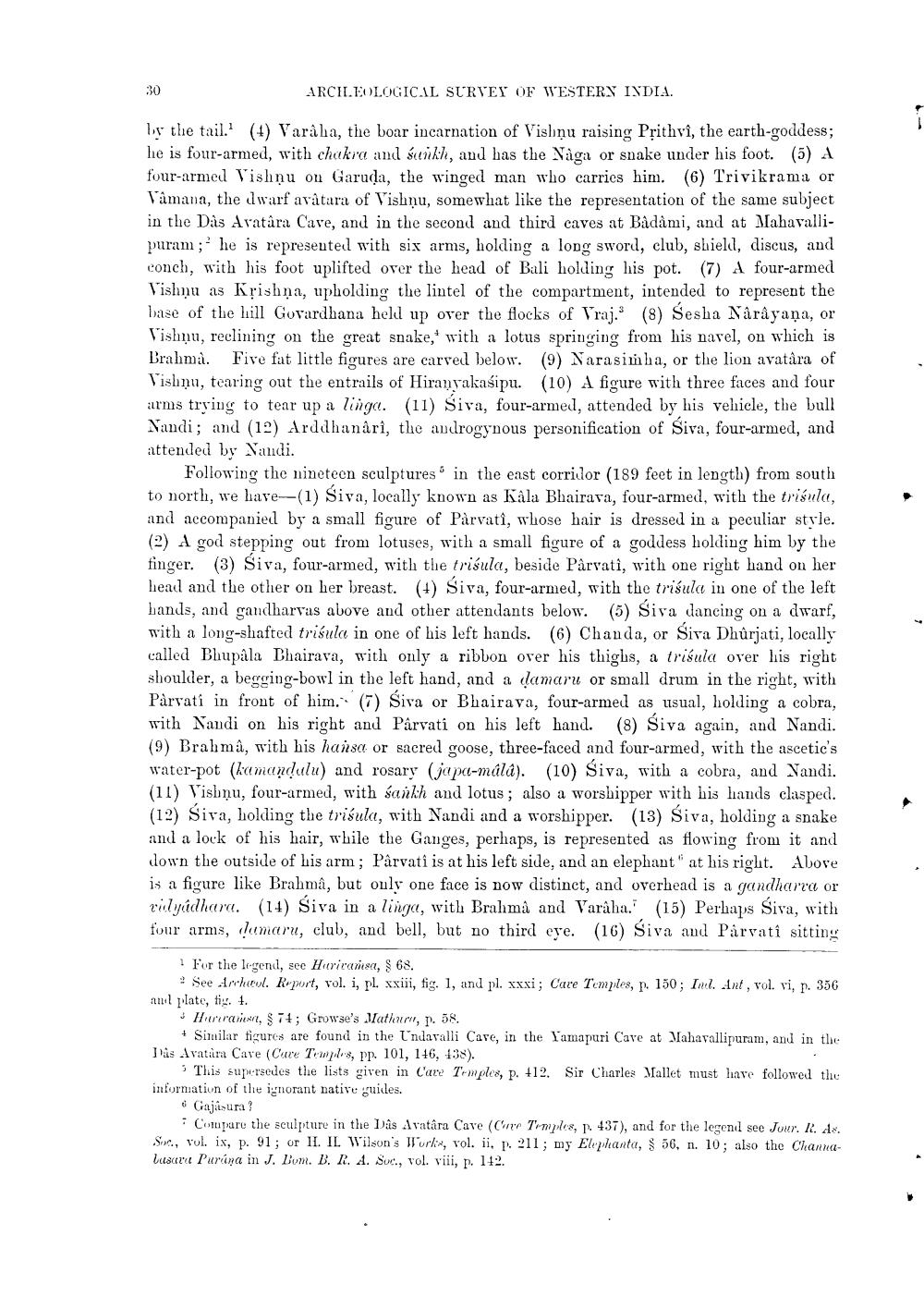________________
30
ARCHEOLOGICAL SURVEY OF WESTERN INDIA.
by the tail. (1) Varâla, the boar incarnation of Vishiņu raising Prithvî, the earth-goddess; he is four-armed, with chakra and sunkh, and has the Naga or snake under his foot. (5) A four-armed Vishnu on Garuda, the winged man who carries him. (6) Trivikrama or Vamana, the dwarf avâtara of Vishnu, somewhat like the representation of the same subject in the Das Avatara Cave, and in the second and third caves at Badami, and at Mahavallipuram ;' he is represented with six arms, holding a long sword, club, shield, discus, and conch, with his foot uplifted over the head of Bali holding his pot. (7) A four-armed Vishņu as Krishna, upholding the lintel of the compartment, intended to represent the base of the hill Govardhana held up over the flocks of Vraj. (8) Sesha Narayana, or Vishnu, reclining on the great snake, with a lotus springing from his navel, on which is Brahma. Five fat little figures are carved below. (9) Narasimha, or the lion avatâra of Vishņu, tearing out the entrails of Hiranyakasipu. (10) A figure with three faces and four irms trying to tear up a linga. (11) Siva, four-armed, attended by his vehicle, the bull Nandi; and (12) Arddhanârî, the androgynous personification of Siva, four-armed, and attended by Nandi.
Following the nineteen sculptures in the east corridor (189 feet in length) from south to north, we have--(1) Siva, locally known as Kala Bhairava, four-armed, with the trisula, and accompanied by a small figure of Parvati, whose hair is dressed in a peculiar style. (2) A god stepping out from lotuses, with a small figure of a goddess holding him by the finger. (3) Siva, four-armed, with the trisula, beside Pârvati, with one right hand on her head and the other on her breast. (1) Siva, four-armed, with the trisula in one of the left bands, and gandharvas above and other attendants below. (5) Siva dancing on a dwarf, with a long-shafted trisula in one of his left hands. (6) Chanda, or Siva Dhûrjati, locally called Bhupala Bhairava, with only a ribbon over his thighs, a trisula over his right shoulder, a begging-bowl in the left hand, and a damaru or small drum in the right, with Parvati in front of him. ( Śiva or Bhairava, four-armed as usual, holding a cobra, with Nandi on his right and Pârvati on his left hand. (8) Śiva again, and Nandi. (9) Brahma, with his hansa or sacred goose, three-faced and four-armed, with the ascetic's water-pot (kamandulu) and rosary (japa-málá). (10) Śiva, with a cobra, and Nandi. (11) Visliņu, four-armed, with sankh and lotus; also a worshipper with his hands clasped. (12) Siva, holding the trisula, with Nandi and a worshipper. (13) Siva, holding a snake and a lock of his hair, while the Ganges, perhaps, is represented as flowing from it and down the outside of his arm; Pârvati is at his left side, and an elephant" at his right. Above is a figure like Brahmâ, but only one face is now distinct, and overhead is a gandharra or vilyádhara. (14) Siva in a linga, with Brahma and Varaha. (15) Perhaps Siva, with four arms, humaru, club, and bell, but no third eye. (16) Siva and Pârvatî sittiny
1 For the legend, sec Harirarea, $ 68.
? See Arhovl. Report, vol. i, pl. xxiii, fig. 1, and pl. xxxi; Care Temples, p. 150; Iml. Ant, vol. vi, p. 356 anil plate, tix. 1.
Hurrat , $74; Growse's lathar, 1. 58.
+ Similar figures are found in the Undavalli Care, in the Yamapuri Cave at Mahavallipuram, and in the l's Avatara Cave (Cave Temples, pp. 101, 146, 138).
5 This supersedes the lists given in Cave Temples, p. 112. Sir Charles Mallet must have followed the information of the ignorant native guides.
. Gajasura ?
- Compare the sculpture in the Das Avatara Cave (C Temples, p. 437), and for the legend see Jour. R. ds. S., vol. ix, p. 91 ; or HI. IL Wilson's Worlu, vol. ii. 211; my Elephanta, $ 56, n. 10; also the Channalusar Purina in J. Dom. 1. R. A. Soc., vol. viii, p. 112.




